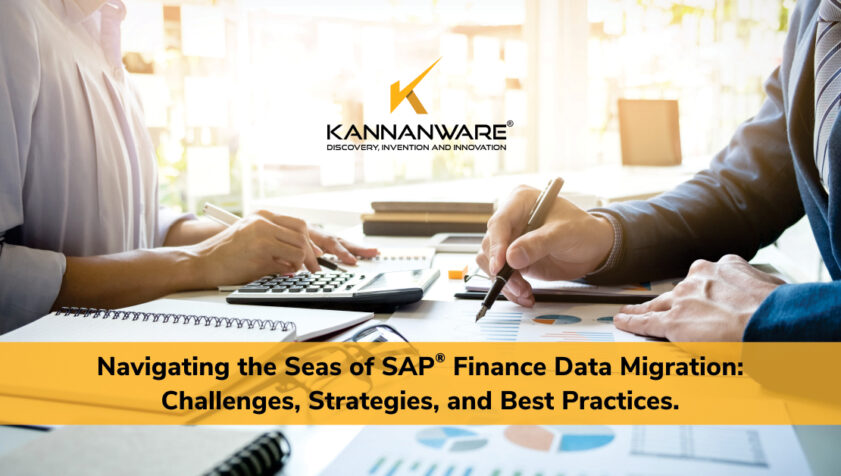In the dynamic landscape of business operations, companies are constantly seeking ways to optimize their processes and enhance efficiency. The adoption of robust Enterprise Resource Planning (ERP) systems, such as SAP® Finance, has become a cornerstone for organizations aiming to streamline their financial management. However, the successful implementation of SAP® Finance is contingent upon the seamless migration of data from legacy systems, a process that presents a myriad of challenges and complexities. Kannanware, the SAP® expert delves into the intricacies of SAP® Finance data migration, exploring the challenges it poses, strategies for successful execution, and best practices to ensure a smooth transition.
Challenges in SAP® Finance Data Migration
Data Quality and Consistency: Ensuring the quality and consistency of data is a fundamental challenge in SAP® Finance data migration. Inaccuracies, inconsistencies, and duplicate entries can lead to erroneous financial reporting, impacting decision-making processes.
Data Volume and Complexity: Organizations often grapple with vast volumes of data stored in diverse formats across multiple systems. Migrating this complex data structure to SAP® Finance requires a meticulous approach to avoid data loss or corruption during the transfer.
Data Mapping and Transformation: Mapping data from legacy systems to the SAP® Finance structure is a complex task. Data may need transformation to align with SAP®’s data model, and discrepancies in data formats or structures can impede the migration process.
Downtime and Business Disruption: The migration process may require downtime, causing disruptions to normal business operations. Minimizing downtime and ensuring a smooth transition are critical to maintaining business continuity.
Regulatory Compliance: Compliance with financial regulations is paramount. Data migration must adhere to legal and regulatory requirements, and failure to do so can result in severe consequences, including financial penalties.
Strategies for Successful SAP® Finance Data Migration
Thorough Planning: A comprehensive migration plan is essential. Define clear objectives, allocate resources, and establish timelines to ensure a systematic and organized approach to data migration.
Data Cleansing and Validation: Prioritize data quality by cleansing and validating data before migration. Implementing data quality tools and conducting thorough testing can help identify and rectify inconsistencies.
Data Mapping and Transformation Tools: Utilize advanced data mapping and transformation tools to streamline the process of aligning data from diverse sources to the SAP® Finance data model. Automation can enhance accuracy and reduce manual errors.
Parallel Testing: Conduct extensive parallel testing to validate the accuracy of migrated data. This involves running SAP® Finance in parallel with the existing system to identify and rectify any discrepancies before full deployment.
Incremental Data Migration: Opt for an incremental data migration approach, where data is migrated in stages rather than all at once. This reduces the risk of errors and allows for a phased implementation, minimizing downtime.
Best Practices in SAP® Finance Data Migration
Engage Stakeholders: Involve key stakeholders from finance, IT, and other relevant departments in the migration process. Their insights can contribute to a more accurate mapping of business processes to SAP® Finance.
Data Archiving and Purging: Implement data archiving and purging strategies to eliminate redundant or obsolete data before migration. This not only reduces the volume of data but also enhances system performance.
Documentation: Document every aspect of the data migration process, including data mapping, transformation rules, and testing procedures. A well-documented process facilitates knowledge transfer, training, and future audits.
Training and Change Management: Provide comprehensive training to end-users on the new SAP® Finance system. Effective change management ensures a smooth transition, minimizes resistance, and maximizes user adoption.
Post-Migration Support: Establish a robust post-migration support system to address any issues that may arise after the data migration is complete. Proactive monitoring and timely resolution of issues contribute to the overall success of the migration.
The bottom-line
SAP® Finance data migration is a complex undertaking that requires careful planning, meticulous execution, and a commitment to data quality. By addressing challenges such as data quality, volume, and mapping through strategic planning and best practices, organizations can navigate the seas of SAP® Finance data migration successfully. With a well-executed migration, businesses can unlock the full potential of SAP® Finance, streamline financial processes, and position themselves for sustained growth in the ever-evolving business landscape. Outsourcing the process to a professional firm like Kannanware works wonders from a long term perspective.







